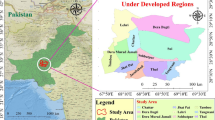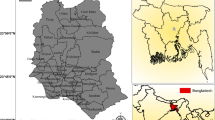Abstract
Large-scale assessment of the amount of different air pollutants is routinely conducted using satellite images. This information is not useful in urban areas where more precise information is needed. In this work, a model called quantitative assessment of different air pollutants (QADAP) was prepared. The ability of QADAP is to produce images quantifying pollutant distribution throughout the city of Tehran at 500 m resolution. The model is based on surface reflectance changes due to air pollution. For this, the city was classified into various classes using GeoEye images. Then the reflectance of each class was calculated using this classified image along with a Hyperion image of the same region. Next, using this spectral information, a MODIS reflectance reference image in its first seven bands was prepared using MODIS image overlaid with the prepared classified image on a clear and clean sky. Then, some coefficients were calculated using surface reflectance differences between polluted days and the referenced clean day image. Required equations were then obtained by relating the pollution coefficients to the values of air pollutants measured in the pollution monitoring stations. Finally, given the equations and coefficients, pollutant concentration was calculated for each pixel and consequently daily images of different pollutants were produced. Data from ground stations were subsequently used to evaluate the model. The best results were for CO, PM2.5, NO2 and O3, which had lower relative Root Mean Squared Errors (RMSE), and the worst result was for PM10 with a high relative RMSE. The relative error of the model was 13–25% for higher levels of pollution and 150–400% for lower values. Finally highly polluted areas were determined by accumulation of different pollution images acquired on consecutive days; this aggregated image was used to identify the most contaminated regions considerably in agreement with the ground measured values.








Similar content being viewed by others
References
Alidoost F, Mobasheri MR, Abkar A (2013) Introducing a method for spectral enrichment of the high spatial resolution images. PFG 1:0031–0041. doi:10.1127/1432-8364/2013/0156
Bechle MJ, Millet DB, Marshall JD (2013) Remote Sensing of exposure to NO2: satellite versus ground-based measurement in a large urban area. Atmos Environ 69:345–353. doi:10.1016/j.atmosenv.2012.11.046
Bucsela EJ, Celarier EA, Wenig MO (2006) Algorithm for NO2 vertical column retrieval from the ozone monitoring instrument. IEEE Trans Geosci Remote Sens 44(5):1245–1258. doi:10.1109/TGRS.2005.863715
Burrows JP, Weber M, Buchwitz M, Rozanov VV, Ladstatter-Weissenmayer A, Richter A, DeBeek R, Hoogen R, Bramstedt K, Eichmann KU (1999) The global ozone monitoring experiment (GOME): mission concept and first scientific results. J Atmos Sci 56:151–175
Chance K (2002) OMI algorithm theoretical basis document, OMI Trace Gas Algorithms, 4th edn. Smithsonian Astrophysical Observatory Cambridge
Frost GJ, Kim SW, Brioude J, Trainer M, McKeen S, Hsie EY, Angevine W, Lee SH, Granier C, Ryerson T, Peischl J, Fehsenfeld F (2011) Evaluating NOx emissions using satellite observations. NOAA, Earth System Research Laboratory Boulder, CO, USA
Georgoulias AK, Balis D, Koukouli ME, Meleti C, Bais A, Zerefos C (2009) A study of the total atmospheric sulfur dioxide load using ground-based measurements and the satellite derived sulfur dioxide index. Atmos Environ 43:1693–1701. doi:10.1016/j.atmosenv.2008.12.012
Hejazi A, Mobasheri MR, Ahmadian Marj A (2014) Optimization of an experimental model using genetic algorithm for assessment of PM2.5 in Tehran using satellite and synoptic data. Geogr Environ Plann 25(54–2):37–50
Karimian H, Li Q, Li C, Jin L, Fan J, Li Y (2016) An improved method for monitoring fine particulate matter mass concentrations via satellite remote sensing. Aerosol Air Qual Res 16:1081–1092. doi:10.4209/aaqr.2015.06.0424
Lamsal LN, Krotkov NA, Celarier EA (2014) Evaluation of OMI operational standard NO2 column retrievals using in situ and surface-based NO2 observations. Atmos Chem Phys 14:11587–11609
Li L, Yang J, Wang Y (2015) Retrieval of high-resolution atmospheric particulate matter concentrations from satellite-based aerosol optical thickness over the Pearl River Delta Area, China. Remote Sens 7:7914–7937. doi:10.3390/rs70607914
McCormick BT, Herzog M, Yang J, Edmonds M, Mather TA, Carn SA, Hidalgo S, Langmann B (2014) A comparison of satellite- and ground-based measurements of SO2 emissions from Tungurahua volcano, Ecuador. J Geophys Res Atmos 119:4264–4285. doi:10.1002/2013JD019771
Noia AD, Sellitto P, Frate FD, Laat J (2013) Global tropospheric ozone column retrievals from OMI data by means of neural networks. Atmos Measure Tech 6:895–915. doi:10.5194/amt-6-895-2013
Popp C, Brunner D, Damm A, Roozendael MV, Fayt C, Buchmann B (2012) High-resolution NO2 remote sensing from the Airborne Prism EXperiment (APEX) imaging spectrometer. Atmos Measure Tech 5:2211–2225
Rakitin VS, Shtabkin YA, Elansky NF, Pankratova NV, Skorokhod AI, Grechko EI, Safronov AN (2015) Comparison results of satellite and ground-based spectroscopic measurements of CO, CH4, and CO2 total contents. Remote Sens Atmos Hydros Underlying Surf 28–6:533–542. doi:10.1134/S1024856015060135
Streets DG, Canty T, Carmichael GR, Foy B, Dickerson RR, Duncan BN, Edwards DP, Haynes JA, Henze DK, Houyoux MR, Jacob DJ, Krotkov NA, Lamsal LN, Liu Y, Lu Z, Martin RV, Pfister GG, Pinder RW, Salawitch RJ, Kevin J. Wecht KJ (2013) Emissions estimation from satellite retrievals: a review of current capability. Atmos Environ 77:1011–1042. doi:10.1016/j.atmosenv.2013.05.051
Zhang T, Liu G, Zhu Z, Gong W, Ji W, Huang Y (2016) Real-time estimation of satellite-derived PM2.5 based on a semi-physical geographically weighted regression model. Int J Environ Res Public Health 13:974. doi:10.3390/ijerph13100974
Zoogman P, Jacob DJ, Chance K, Worden HM, Edwards DP, Zhang L (2014) Improved monitoring of surface ozone by joint assimilation of geostationary satellite observations of ozone and CO. Atmos Environ 85:254–261. doi:10.1016/j.atmosenv.2013.11.048
Author information
Authors and Affiliations
Corresponding author
Electronic supplementary material
Below is the link to the electronic supplementary material.
Rights and permissions
About this article
Cite this article
Ahmadian Marj, A., Mobasheri, M.R. & Matkan, A.A. Quantitative Assessment of Different Air Pollutants (QADAP) Using Daily MODIS Images. Int J Environ Res 11, 523–534 (2017). https://doi.org/10.1007/s41742-017-0046-y
Received:
Revised:
Accepted:
Published:
Issue Date:
DOI: https://doi.org/10.1007/s41742-017-0046-y




